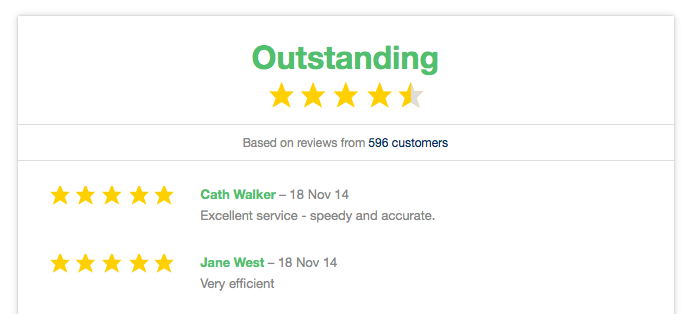

“Learn, in depth, with success stories, everything that reviews can do for your business (clue: it’s not just increase sales).”
Daunting
That’s how it feels when you start to think about just reading how your customers really feel about you, let alone allowing them to declare it to the world on your website.
But there’s no doubt displaying customer reviews can increase sales. A merit badge that proves you’re one of the customer service ‘good guys’.
And there’s a much bigger benefit that most people miss.
To help you overcome the anxiety, reap the benefits and avoid the bear traps, here’s the experience we’ve gained from helping hundreds of businesses around the world accumulate hundreds of thousands of customer reviews.
And, in their own words, the reasons why they do it.
Just to be clear, I’m covering service reviews in this post, not product reviews. That is - why someone should buy from you, not what someone should buy from you.

We all read reviews when we’re buying, don’t we?
We feel nervous if we can’t find some way to validate our choice and reassure us we’re not going to hit problems. Buyers crave reviews and they have a powerful influence over purchasing decisions.
But what about when we’re selling?
Well then, we may feel a little more coy. Despite the fact we know this applies just as much to buyers checking out our own website.
By sharing some hard data, and the experience of other merchants who’ve taken the plunge, I’d like to help you make an informed decision about the value of customer reviews for your business.

Chris at SeedsNow says:
“Customer feedback has been critical to our success. For us, the most beneficial part is the ability to gather reviews. They are absolutely priceless.”
It turns out that faced with a choice of buying something from two companies, all other things being equal (price, quality, availability, ease of ordering, returns policy…) the sale goes to the one displaying transparent feedback on their website.
…it de-risks the purchase because they can tell exactly what your company is like to do business with.
…it’s like playing a trump card to beat your competitors.
It’s the online equivalent of letting people look in your shop window to see how customers are treated and seeing whether they’re smiling or frowning when they leave.
Which, incidentally, is why it’s beneficial to have problems visible in your reviews.
More on that shortly.

Fortunately, you can get substantial benefits from inviting feedback and using it internally, whether or not you display it on your website. So, the decision on whether or not to show it in public needn’t hold you back.
ShoeMe, one of Canada’s largest online retailers, is meticulous about customer satisfaction and they describe it in a succinct way that’s typical of their clarity and focus:
“Customer feedback is a terrific way to make sure we keep delivering a top-notch customer experience.” Their dramatic and rapid growth is testament to the success of their approach.
Each time you deliver a product or a service, there’s only one person who can tell you whether you got it right.
The customer who received it.
If you believe in great customer service, inviting feedback is the difference between hoping for the best, and making absolutely sure the best has happened.
Reviews can feel scary. And we’re busy. Powerful reasons for doing nothing. So, will the return on the effort and investment really be worth it?
Excellent question.
Figures on the increase in sales vary. I’ve seen people quote anything from 2% to as high as 67%.
It also depends on these factors:
Keeping on top of replies, and demonstrating action, is vital too, if those extra sales are to be unlocked.
So, the amount varies, but there’s general agreement that there’s a substantial sales premium if you display reviews.
But focusing on sales conversions, and the marketing benefits of a page of glittering comments, is to miss the biggest benefit of all…
Surprisingly it turns out that increasing sales isn’t the only benefit. More surprising - it’s not even the biggest one.
The biggest benefit comes from making customer feedback part of ‘business as usual’.
Not just something the marketing team does to try and add a few points to sales conversions, but a core activity within the whole business that improves retention, increases word-of-mouth referrals and helps everyone on your staff team stay tuned in to what each customer likes, and what they don’t.
That way, and only that way, do you make every customer a loyal customer.
And that shouldn’t be a surprise, because addressing the unique requirements of each individual customer is how you won them in the first place.
Reviews can win new customers for sure, but that’s their job done. They offer no more. After that only consistently excellent service can keep them coming back. So, the way to keep customers once you’ve won them, and to accelerate the growth of your business, is to make customer feedback central to everyone’s job.
Jonathan Ford wrote recently about his experience of collecting customer reviews. Here’s an extract in which he lists the benefits his firm has seen:
- If we’re not getting something right, then we want to know about it. We do our best to provide a really good service so if we’re falling short in some way then that’s a significant piece of information for us.
- It can help prevent us from losing a client. People often don’t bother raising a complaint with service providers – they just start using someone else. If we get an early indication that something isn’t right, we can take steps to sort it out.
- It’s nice to get good feedback. We all like a pat on the back now and again. Sometimes the feedback has highlighted something particularly good a member of staff has done that we wouldn’t know about otherwise.
- We can use our reviews to help attract new clients. Most firms of accountants aren’t quite so honest and upfront about what their clients think (apart from a few cherry-picked comments on the web site). We think providing much more information – warts and all – gives our prospects an honest view of what to expect from us.
- We can use our reviews to identify clients who think so highly of us that they may be happy to refer us to others – creating the potential for new work.
And the policy of using an independent review service means we’re unable to edit or delete reviews so people know we can’t cheat!
What would be the impact on your business of:
In my previous role this represented £1.2 million of revenue and that’s why I set up CustomerSure. It’s a source of great joy to me that the model is as true for our customers today as it was when I first learnt these lessons six years ago.
In a second, I’ll put numbers on the results you can expect. But first let me share with you the most common pattern I’ve observed amongst businesses who start out collecting customer reviews.
It boils down to this:
Averages, by definition, mask a range of results. But you can get a feel for some norms if you have a big sample.
Fortunately, we have a very big sample. We recently took 100,000 responses from our database of satisfaction scores and made them anonymous.
This is what we found:

Overall, that looks pretty good, don’t you think? 89% of customers either very happy or moderately happy. They’re probably not going anywhere else.
But if you look at it the other way, it means 11,000 customers are seriously dissatisfied about some aspect of the service they’ve received and may be hanging on by a thread.
(Fortunately, that’s 11,000 customers that businesses who use CustomerSure have had the chance to save, by finding their problems and fixing them – rather than letting them walk silently away to a competitor!)
This sample is from our customer base not the whole universe of companies. So, it’s the people who’ve already invested to make sure they’re delivering great service. The good guys.
The most common question of all.
And you probably know the answer by now.
Bad reviews are BRILLIANT.
Granted, it doesn’t feel like that when they come in.
These aren’t my conclusions - it’s what our customers tell us.
So be reassured. People who visit your website and see a bad comment are not comparing you with other perfect companies who only have 5-star reviews. Those companies do not exist (or they are tampering with their reviews).
Instead you are being compared against companies who have no reviews at all. And that makes them far riskier for a new customer to choose.
The quality of their customer service is unknown. Do they even care? There’s no evidence to go on.
Service is a key consideration in purchasing decisions. No prospective buyer wants hassle. And if they’re a buyer who will ignore service, and choose on the basis of a few pennies cheaper, you don’t want those customers anyway, because they’ll be off as soon as someone else is cheaper still.
It becomes a race to the bottom on price.
Now clearly, an ocean of bad reviews is not going to help. But assuming they’re the exception, then they will help.
Sure, it won’t feel great when one lands. But if you deal with the problem quickly, and post a professional reply, you’ll save one customer and win others by being transparent.
We hope you’ve found this guide to customer reviews helpful, and we’ve got a lot more where this came from. Go and check out our mix of resources, designed to teach you the basics of customer experience and feedback so that you can make a running start. We recommend starting with this guide to [the benefits of a robust VoC programme] (/why-customer-feedback-is-important/), to get you excited about the journey ahead.
We’ve been there and got the VoC t-shirt, in fact we’ve got a whole wardrobe! Come and take a look at how we can use our expert knowledge to drive measurable improvements to key customer satisfaction metrics, and how we can make our proven methodology work for you and your business.

Ready to elevate your VoC programme and ensure success using our expert guide? Learn the three foundations required for success.
Discover more »Connect with a CX expert who’ll help determine your current VoC programme maturity level and provide a 3-step action plan to improve.